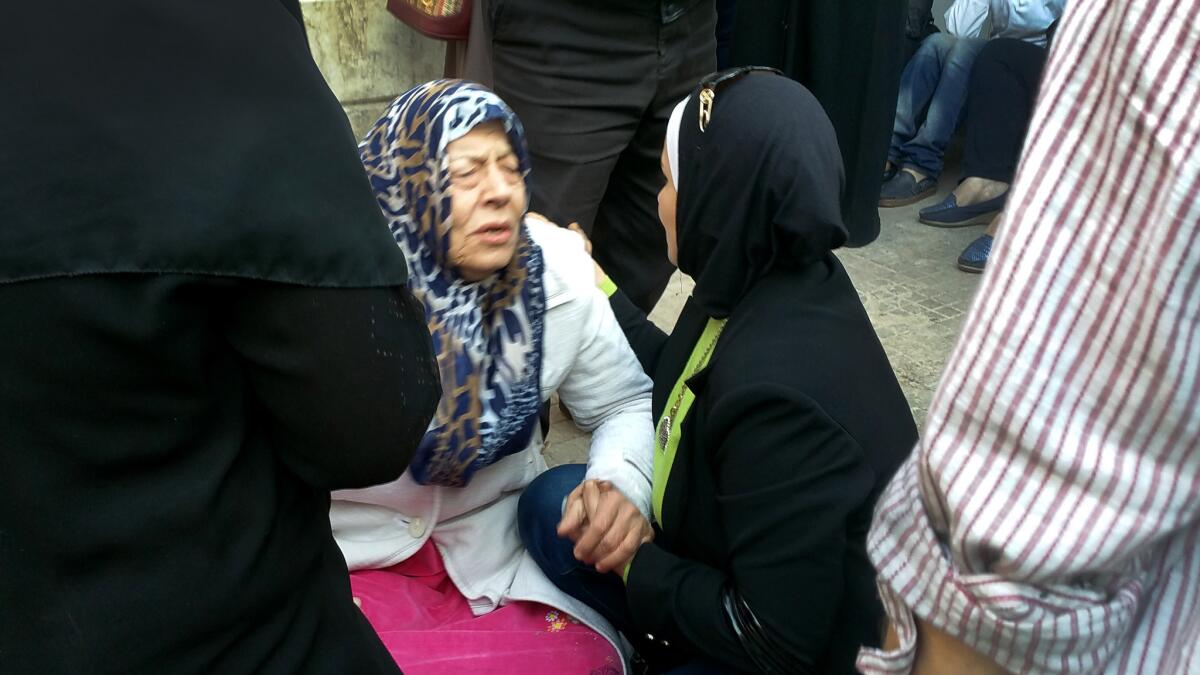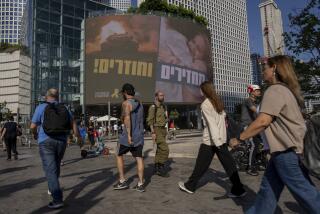Visions of hell: Another day in Aleppo, ancient city under siege

Reporting from ALEPPO, Syria — The crowd convulsed and parted when a medic commanded, “Make a path! Make a path!,” as he and his colleagues pushed a gurney through the narrow emergency room entrance of the Razi hospital.
His shouts rose above the shrieking of the woman running behind him.
For the record:
7:04 p.m. Aug. 22, 2019A previous version of this article included a caption that identified a victim of a mortar attack as Dr. Hazem Sharifeh. The victim was Ayman Shehadeh.
“Save my son! Please save my son! He’s my only son. I have no one other than him,” she screamed. Her voice faltered for a moment as the doors of the emergency wing closed behind the doctors, who would try to save the life of her son, Dr. Hazem Sharifeh. He too was a physician, now a gravely injured patient.
It was another day in the slaughterhouse that is Aleppo, once one of the jewels of the Middle East, now reduced to ruin as Russian-backed forces loyal to the government of Syrian President Bashar Assad battle the opposition fighters arrayed against him.
The mother, who did not give her name, leaned on the wall and crumpled to the floor as she continued her pleading.
“I was leaving the house. He was behind me, and then the mortar fell. There was smoke and then we came here. I’ll kiss your feet, please save him. Please,” she cried.
A volunteer worker picked her up, put his hands on her shoulders and repeated that her son was still alive.
Inside, doctors shouted impatiently as they wheeled more patients through. On one side stood a soldier, his uniform coated with a film of dust, his eyes glazed over. He seemed immune to the chaos as he waited for news of comrades being treated inside.
This is the new norm in Aleppo, one of the world’s oldest human settlements, once the vibrant heart of Syria’s economy. Six years of war have transformed its neighborhoods, known for houses with graceful window arches and ornately patterned walls, into a battleground each side is desperate to win, dividing Aleppo into spheres of government and opposition control.
As the belligerents have fought each other to a standstill, civilians in both parts of the city suffer under a constant barrage of shelling, and, in the case of rebel-held east Aleppo, relentless government airstrikes that have reduced the area to a wasteland where thousands have been killed.
In the east, entire blocks have become little more than pits of masonry and twisted metal, where residents fish out victims whose faces have been cast in shades of white and red — white from dust, red from blood.
But this can also be seen in the government-held west, where officials say rebel shelling has left about 11,000 dead since 2012.
On Thursday, the Army of Conquest, an alliance of hard-line Islamists coordinating with mainstream opposition groups, launched the second phase of a do-or-die attempt to break the government’s siege on the opposition-controlled areas of the city, home to an estimated 250,000 people. The blockade, first mounted in July, has caused price hikes as residents expect food shortages to begin, according to pro-opposition activists.
Other factions peppered the government-held areas in the city with Grad rockets and mortar shells, while inghimasis, jihadists who would fight till the last bullet and then blow themselves up, advanced to breach government defensive lines and open a corridor to the besieged areas inside.
Hours earlier, as the walls of Aleppo’s majestic citadel blushed pink with the first rays of sun, government forces lobbed artillery at rebel positions outside the city. The booms echoed through its boulevards, rattling windows even as smoke wreathed the area.
The clashes came one day before a deadline set by Russian President Vladimir Putin, who extended a two-week cessation of airstrikes until Friday evening to “avoid senseless victims,” according to a statement from Russian Defense Minister Sergei Shoigu. People would be allowed to exit the rebel enclave from 9 a.m. until 7 p.m. Friday.
Rebels rejected the truce, insisting they would not leave, according to an interview given by a rebel commander, Ahmad Berri, to the Saudi-run Al Arabiya television channel.
The stream of ambulances racing to the Razi hospital, the main public hospital in west Aleppo, hinted at the offensive’s fury. Drivers, many of them weary Syrian Red Crescent workers, would stop for an instant to drop off the casualties. Medics scurried to load a fresh gurney before the ambulance, tires screeching on the tarmac, raced back to retrieve others felled in the carnage.
“They’re still coming. We don’t know how many we’re going to get,” said one medic, his hands covered in gloves. He raised them like a soccer goalkeeper as a car bearing yet another casualty swung into view.
In one of the hospital rooms, a soldier, Shadi Rojiyeh, calmly looked on as a nurse wrapped a bandage around his bloodied leg. He seemed unperturbed by the blood oozing from a cut near his left eye.
“Tanks came at us, but we managed to repel them,” he said before he slowly walked out of the room.
By the early evening, 13 people had been killed and at least 150 wounded, said Dr. Mazen Rahmoun, the deputy head of the state health directorate in Aleppo.
“We’re not talking about military personnel. All the numbers I gave you are for civilians,” Rahmoun said.
At the rear of the hospital, a throng of people gathered in front a short staircase leading down to a pale-blue metal door: the Razi morgue.
Members of one family milled almost in slow motion. They were waiting to receive the body of Ayman Shehadeh, a 53-year-old government employee.
His wife, Itidaal, recounted how her husband had parked their car at a roundabout outside their house in the Hamdaniya neighborhood in southwest Aleppo.
“I was looking from the balcony when the projectile fell. When I saw the glass break, I knew something had happened to him,” she said.
Beside her stood her son, Adel, a green-eyed boy of 11 wearing a black Puma tracksuit and sneakers with orange laces.
“The car was broken,” he said.
Around them, other members of the family, all of them red-eyed, passed a phone around, whispering, “What should we tell her?” On the line was Shehadeh’s mother.
When she arrived to the morgue’s entrance, men of the family surrounded her to tell her the news of her son’s death.
Her legs buckled; she fell to the ground like a marionette whose strings had been cut. Then she screamed, slapping her two hands against her face. She begged her family to see her son, her voice turning to a croak.
But it spurred a fresh bout of crying from the family. One of them asked God to “take revenge against them,” referring to the rebels.
The family members shepherded one another to the sidewalk when another ambulance drove up to the morgue’s entrance.
Inside was a corpse covered in a blue sheet. The medic pulled it back.
“He was brought in before. His mother was the one inside who was hysterical,” he said.
It was Sharifeh, the young doctor. Below his chest, situated slightly off center, was a coin-size hole where shrapnel had penetrated his heart. The doctors could not save him.
Bulos is a special correspondent.
ALSO
Don’t be like Gary Johnson: 8 things you should know about Aleppo, including what it is
Russia portrays its Aleppo bombing as a Mosul-style offensive
Mexico City restaurant serves up nostalgia, with seating for 2,200
More to Read
Sign up for Essential California
The most important California stories and recommendations in your inbox every morning.
You may occasionally receive promotional content from the Los Angeles Times.











